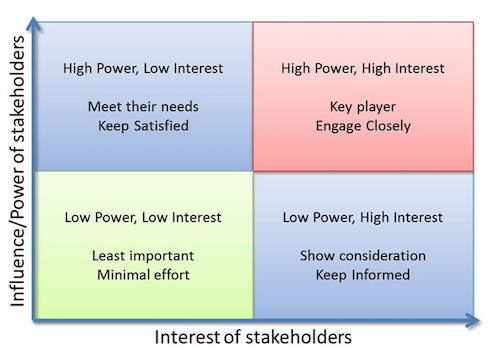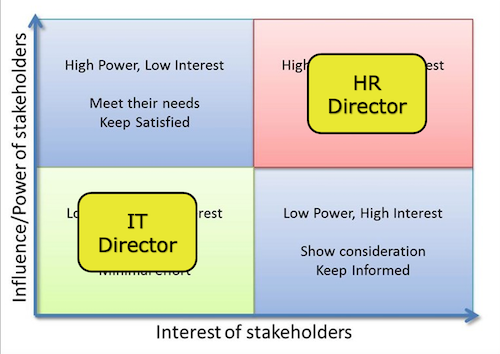To complement our series of QuickReads covering measurement, we will now explore Failure Demand (FD).…

ChangeWise Quick Read: Power Interest Grid
In this article, we take a look at the Power Interest Grid, including why it is useful in managing effective change and how to create one for your Lean improvements.
What is a Power Interest Grid?
A power interest grid is a simple tool for categorising stakeholders during a project or lean review. It informs the project manager of the best way to manage and communicate information to those who are involved in the change.
Sounds good…..but what exactly do you mean by ‘Stakeholder?’
That’s a great question. Stakeholders are any one or any group of individuals who have an interest in your project/lean review. They might be positively or negatively impacted as a result of the planned changes.
Ok, I get it – but why do I need to create a Power Interest Grid?
Once you have a better understanding of your stakeholders in terms of their power, influence and interest in your project, you can ensure they are updated with the appropriate information at the correct times throughout your project. This will give your project the best possible chance of success.
I like it, can you tell me how to create one please?
Absolutely! Creating the grid is simple, just follow these steps…….
Step 1: Identify your stakeholders
As mentioned earlier, this can be anyone who has an interest in or will be impacted by your project – both individuals and groups. The list may include (consider these both internally and externally):
- Customers
- Suppliers
- Management Teams
- Company Shareholders
- Regulatory bodies
- Other teams who may need to provide input/advice/adjust their process/retrain as a result of your project
- Co-Workers
Step 2: Create your Grid
We advise involving your project team when creating the grid, preferably in a workshop environment. Collaborating with others is a great way to make sure you don’t miss any key stakeholders, get everyone engaged and consider other points of view. A large visual grid is also quite impactful and easier to share and discuss, so find yourself a quiet space, a flip chart, some marker pens and Post-It notes!
Start with a square shaped gride and divide it into 4 equal squares. Label the grid with two axis:
- Axis Y (vertical) Influence/Power of Stakeholders
- Axis X (horizontal) Interest of Stakeholders
Finish with labelling each box as shown below:

3: Populate the Grid
Using your list of stakeholders, place them in the appropriate box based on their level of influence/power and interest (this is where Post-It notes are great).
High Power stakeholders are those who can change/stop/make the project happen. They are often an escalation point if things go off track.
Low Power stakeholders may not have the same direct impact, but it is important to keep them onboard as they can be useful supporters.
For example, a Training and Development team looking to change external training suppliers may see the HR Director as High Power/High Interest. This is because the HR Director has overall responsibility for people development and the training budget, they will need to approve any new suppliers and take ownership of any metrics for success. In contrast, the IT Director does not have any authority over supplier choice and is not accountable for training success measures – so they would be Low Power/Low Interest. However, it is still important to update the IT Director with key changes/outputs as their department may be impacted in terms of training availability.

⭐️ Remember!! The Power-Interest Grid is not static, the influence/power and interest of stakeholders can change over time. Revisit your grid regularly to consider these changes and ensure they are reflected in your communication plan/future actions.
Step 4: Create a plan based on the output of the grid
Once you understand how your stakeholders can impact/influence your project, you can start to create a plan of how to keep them engaged/satisfied (we will look at Communication Plans in more detail in a separate article).
- High Power/High Interest Stakeholders should take priority and be managed closely. They have a heavy influence on your project’s success. Ensure you engage them closely and treat as a key player.
- High Power/Low Interest Stakeholders may not have the same impact as High Power/High Interest Stakeholders but you still need to meet their needs and keep them satisfied – they can still significantly impact the project’s ability to deliver.
- Low Power/High Interest Stakeholders are often overlooked but they may provide useful insights and considerations – keep them informed and show consideration.
- Low Power/Low Interest Stakeholders are your least important in terms of communication effort, keep them informed of key milestones and issues but don’t exhaust your resources here.
⚠️ Important Point!! Once you have your stakeholders categorised, think about the best and most productive way to communicate with them; some will be more receptive to weekly calls, others appreciate a monthly email or a weekly one-pager and follow-up. Identify the level of alignment and communication necessary to ensure stakeholders are fully connected and supportive.
In Summary
A power interest grid is a straightforward, yet highly important tool for understanding and categorising stakeholders ahead of a project or lean review. It informs the project manager of the best way to manage and communicate information to those who are involved in the change. An Interest-Power Grid can be created using four simple steps.
Looking for more information? Get in touch with the ChangeWise team at info@changewise.co.uk
ChangeWise believes employee engagement is the foundation for successful Change. Training and coaching your people to use simple continuous improvement techniques will enable your organisation to continuously adapt and stay ahead in a constantly changing and challenging environment.
For updates and interesting Lean Change insights, connect with us on LinkedIn.



